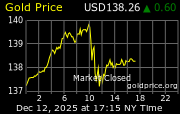Gold remains the universal thermometer of global worries
 The gold price declined Monday morning as a deal was finally struck between President Obama and House Republicans to raise the debt ceiling. When the news broke last yesterday, gold prices spiked as low as $1,607 per ounce. Stocks and cyclical commodities, such as oil, rallied on the announcement of a deal. Investors and traders who purchased gold as an insurance policy against a debt default liquidated positions. However, the price of gold rebounded back to $1,629 Tuesday morning on lingering worries over the possibility of a credit rating downgrade. Whether the debt ceiling agreement went far enough to address the long-term fiscal issues facing the United States was being hotly debated Monday morning.
The gold price declined Monday morning as a deal was finally struck between President Obama and House Republicans to raise the debt ceiling. When the news broke last yesterday, gold prices spiked as low as $1,607 per ounce. Stocks and cyclical commodities, such as oil, rallied on the announcement of a deal. Investors and traders who purchased gold as an insurance policy against a debt default liquidated positions. However, the price of gold rebounded back to $1,629 Tuesday morning on lingering worries over the possibility of a credit rating downgrade. Whether the debt ceiling agreement went far enough to address the long-term fiscal issues facing the United States was being hotly debated Monday morning.“Gold remains the universal thermometer of global worries; and its strength in the face of a firming dollar, is highlighting a bad global financial fever. Topically, there is a very strong correlation between gold and debt levels. We continue to like gold and the gold equities as hedges against uncertainty. Our commodity team is forecasting $1,800/oz for Q4 2011….Gold is likely to continue to benefit from US and European financial uncertainty. With two of the world’s largest currencies tainted, it’s impossible to know when fears (and gold) will subside.”
The above commentary came from a report last week by J.P. Morgan’s Global Commodities Analyst Michael Jansen.
In light of his bullish outlook for gold, J.P. Morgan’s North American equity derivatives team released a note to clients on Monday with an options trading idea to capitalize on higher gold prices.
“Investors who agree that gold is likely to be a good hedge against uncertainty should consider buying the October expiry $163-$177 call spread on Gold, specifically buying the $163 (~3% OTM (out-of-the-money)) calls and selling the $177 (~12% OTM) calls,” according to the firm.
“This trade can be entered into for a net cost of $2.71 (~1.7% of spot). The maximum loss for this trade is the premium paid of $2.71 and the maximum gain for this trade is $11.29.”
J.P. Morgan went on to note that “To determine the maturity we looked at implied volatility percentiles for ATM (at-the-money) out to 5% out-of-money in increments of one percent for August, September, and October expiries over the past three years and found that implied volatilities are in their lowest percentiles for October expiry.”
“Therefore, we like buying the October expiry $163 strike calls. The call spread offers payoff-to premium ratio of ~5 to 1. In addition, the 3-month 100-110 skew is ~1.5% which over the past one year is in its 70th percentile and fairly expensive in our view.”














0 comments:
Post a Comment